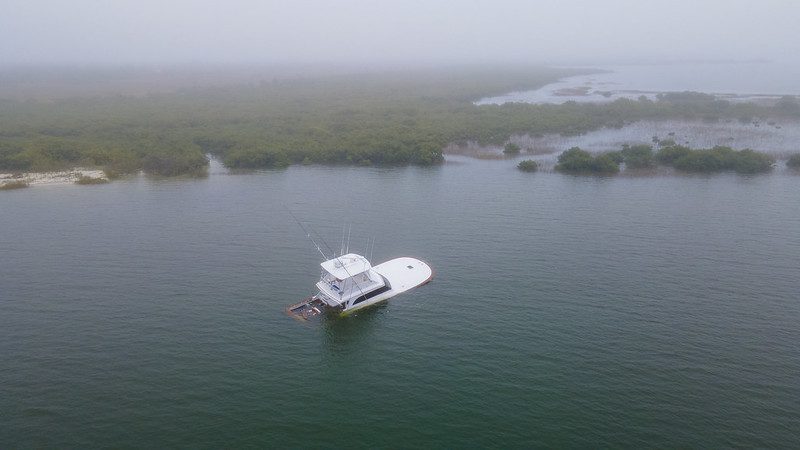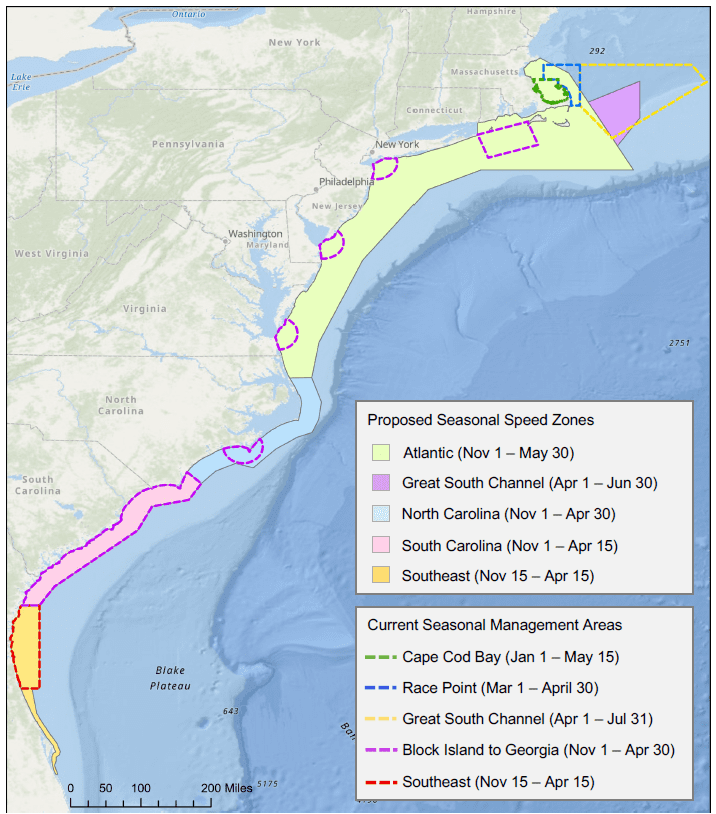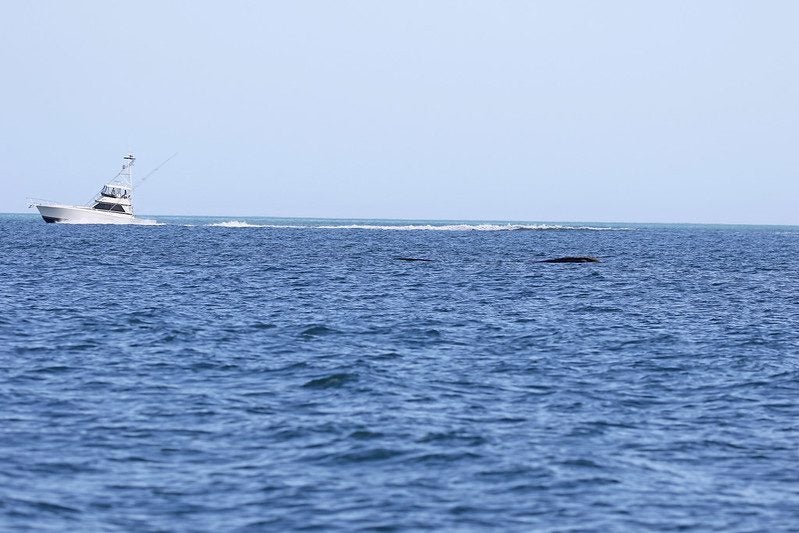November 2, 2022
Small Boats, Big Problems
Every year, the approximately 340 remaining critically endangered North Atlantic right whales swim from Florida to eastern Canada, facing a wide range of threats. These whales risk entanglement in fishing gear and being struck by boats. More than 50 right whales are entangled each year and more than 80% have signs of being entangled each year, leading to the federal government needing to take action to protect these whales.
Another perhaps more insidious threat to North Atlantic right whales is being struck by a passing boat. Each year, tens of thousands of boats, from small recreational boats to massive cargo ships more than 1,000 feet long, travel along the East Coast from Maine to Florida. These waters are also where these whales migrate, breed, feed, and give birth their calves. Each one of these boats poses a risk to North Atlantic right whales, which are hard to see as they do not have dorsal fins and are slow swimmers that may not move out of the way of fast-moving boats. If a boat collides with a whale, both the boater and the whale are at risk. These collisions can cause massive injuries to the whales, including skull fractures and cuts from the propeller that a whale cannot survive.
When boats strike whales, many of these whales sink and die. Scientists estimate that observed deaths are only a small portion of the whole picture. We also know that where there are boats, there is a clear danger to the whales.
For many years, efforts to manage the risk of collisions were focused on larger ocean-going boats and ships greater than 65 feet that crisscross the whales’ migration route and feeding grounds. But recently, more evidence is showing that smaller boats can and do injure and kill North Atlantic right whales. In recent years, eight boats between 35 and 65 feet have reported collisions with North Atlantic right whales, and six large whale strikes may have involved North Atlantic right whales.
In 2021, a sportfishing boat was returning to port in North Florida and struck a mother North Atlantic right whale named Infinity and her calf. Moving at 21 knots (24 MPH) the blades of the boat’s propellers sliced the young calf’s body. The calf had fresh propeller cuts on its back and head, broken ribs, and bruising. The calf was found dead on the shore the next morning.
The mother, named Infinity by researchers, sustained injuries and has not been seen since – raising questions on whether she was able to survive her injuries. Each and every one of these cases is heartbreaking and preventable.
The $1.2M, 54-foot-long boat that hit Infinity was damaged so significantly that the captain had to run it aground on a mud flat before it sank.

It is important to note that small boat captains are not breaking the law by going fast. The current regulations are not sufficient to protect whales from collisions with small boats. But with thousands of boats of all sizes transiting the whales’ habitats every year and the dire status of this endangered species, it is vitally important that the federal government put more effective safeguards in place to reduce this threat.
But what can be done that will still allow economically important boat traffic to continue moving up and down the East Coast? We cannot stop ships from transporting needed cargo into our ports or thousands of boaters and fishermen who enjoy the offshore waters.
The answer is surprisingly simple and familiar to anyone who drives past a school or in a busy parking lot: slow down. Scientific research shows that slowing down boat traffic to 10 knots (11.5 MPH) in areas where whales travel can reduce the risk of death from a boat strike by 80-90%.
This summer, the National Oceanic and Atmospheric Administration (NOAA) — the federal agency responsible for protecting North Atlantic right whales and proposing new safeguards to protect these whales from speeding vessels. The government took public comment for months and is now considering these comments. If approved, mandatory seasonal speed zones will be created in the migration corridor for North Atlantic right whales from Florida to New England where and when the whales are expected to be there. This is a significant shift from previous requirements that relied on both mandatory and voluntary slow zones.

Additionally, NOAA recognizes that in a changing ocean, we can’t always predict where and when North Atlantic right whales will be found in U.S. waters. To protect the whales outside of these seasonal speed zones, under this proposal, NOAA could create new temporary speed zones, triggered by the presence of whales.
Another key update is to include smaller boats greater than 35 feet. The current requirements on apply to boats 65 feet or larger. The proposed expansion would have protected Infinity and her calf.
Setting and enforcing these speed zones to get near 100% compliance is critical to their success.
A Safe(r) Speed Limit for Small(er) Boats
Boat manufacturers, boat owners, and sportfishing captains are sharply critical of the proposed changes. They argue the changes will create safety issues for small boats that are caught in bad weather, big waves, or other inclement conditions. In addition, they maintain the changes will require longer travel times that will be catastrophic to businesses and recreational opportunities will be canceled.
Many of these arguments are inaccurate or not based on the specific changes being proposed. So let’s address these concerns.
First, safety is always the first priority. That’s why the government’s proposal continues to allow for exceptions in instances of bad weather or other extraordinary situations.
Next, a 35-foot boat is by no means small. Many 35-foot boats sleep five people with air conditioning, kitchens, and flat screen TVs in their parlors. These boats that can go on trailers require special tow vehicles that can carry the nearly seven ton vessels. Boats shorter than 34 feet will continue to be exempt from the expanded speed regulations.
Next, travel to and from fishing grounds is part of every fishing trip. Whether it is a short ride for coastal species or a long haul to reach offshore canyon areas and the Gulf Stream, that travel time is part of the expedition. While this rule will certainly add to travel time both ways, it may not be a significant amount. Take the vessel above that hit and killed Infinity and her calf off Florida’s coast in 2021 – that boat was coming in at 21 knots (24 MPH) through a proposed whale speed zone that is about 20 miles wide. Even if the boat needed to transit the entire width of the zone, these new speed limits would add just an hour of travel time each way. This is true for all of the proposed speed zones south of Virginia that are limited to areas close to shore.
Also, the proposed seasonal slow zones are just that: seasonal. Speed limits would only be in effect for the months of the year while the whales are migrating to protect mothers and calves in the Southeast during calving season and when the whales are aggregated in New England.
Some in the recreational boating and fishing community are campaigning against the newly proposed regulations even as the species declines and only about 340 North Atlantic right whales and calves remain.
Boats bigger than 35 feet are large, heavy, and deadly if they hit a whale at high speeds. Those who operate recreational boats larger than 35 feet must also be subject to safeguards to protect the North Atlantic right whale. Their survival may depend on it.

Photo: Florida Fish and Wildlife Conservation Commission, taken under NOAA permit 20556-01
Opposition Is Growing
Some in the recreational boating and fishing community are campaigning against the newly proposed regulations even as the species declines and only about 340 North Atlantic right whales and calves remain.
As comment letters and a recent report in the Florida Phoenix indicate, boat owners and boat captains have noted their opposition to the proposed vessel speed rule and unwillingness to comply with new regulations.
Saving the remaining 340 North Atlantic right whales will take a collective effort from the fishing, boating, and shipping industries to effectively reduce the risk of entanglements and boat collisions. Status quo is not working for this species. Far too many North Atlantic right whales are dying because of boat collisions, and even one collision is too many to allow the species to recover.
We cannot just passively watch a species careen further toward extinction. We need to do all that we can to turn the tide.
Oceana strongly supports the improvements being proposed by the federal government and is grateful for the support of the hundreds of thousands of Oceana members in the U.S. and Canada, particularly the nearly 20,000 who have spoken up to support the proposed effective vessel speed safeguards for North Atlantic right whales. The proposed changes are necessary to conserve the remaining North Atlantic right whales, particularly the mothers that are migrating to the calving grounds off Florida and Georgia this fall. Each new calf brought into the world offers a glimmer of hope for restoring this species, but that will be impossible without swift government intervention.
The federal government has a legal obligation to protect these whales from this clear threat. These rules cannot wait.
Oceana will continue to fight for these changes until the waters of the U.S. Atlantic are safer for North Atlantic right whales.
MOST RECENT
August 29, 2025
August 22, 2025
Corals, Community, and Celebration: Oceana Goes to Salmonfest!



